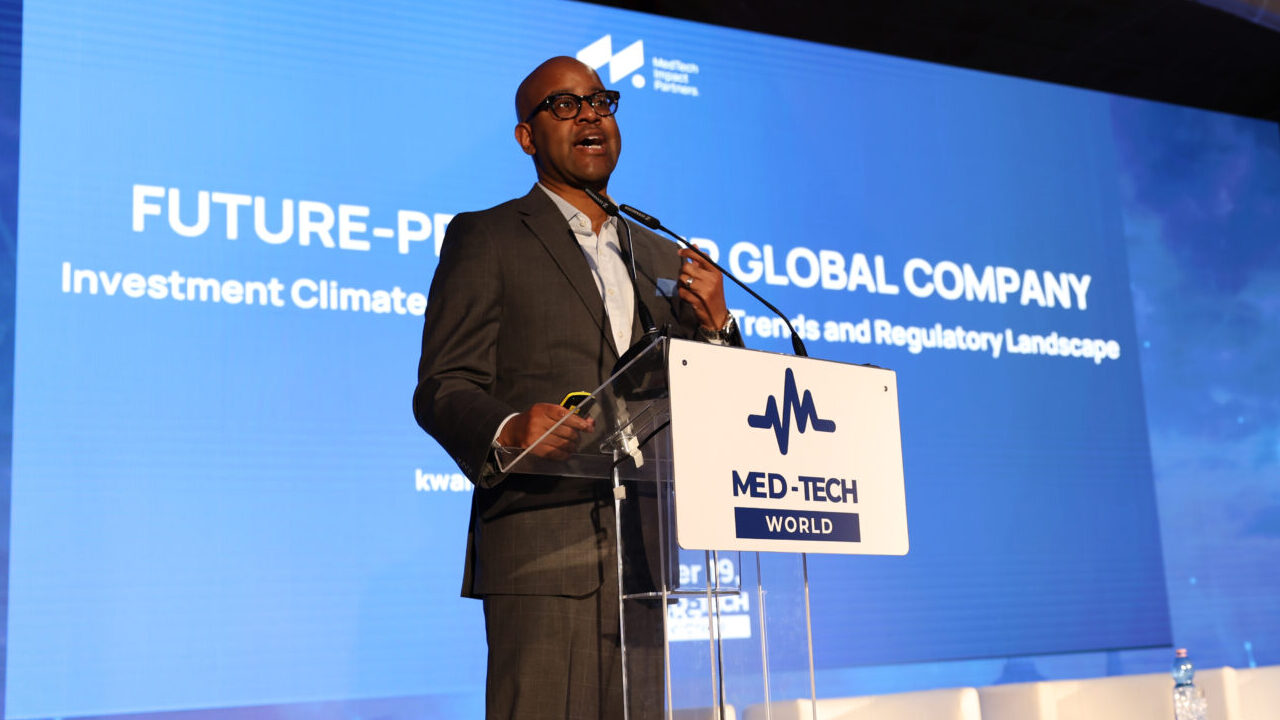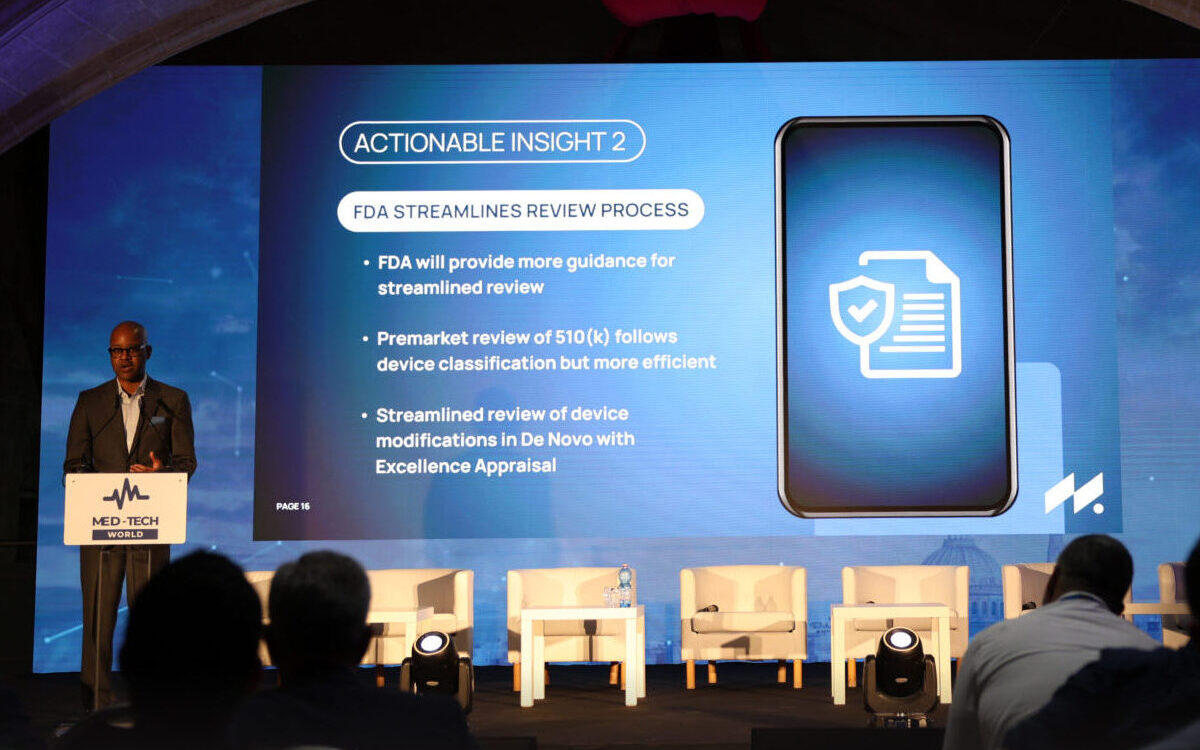
Matthew Calleja
8th March 2024
Future-Proofing Your Global Company and More with Kwame Ulmer
What investment trends are currently dominating the American Healthcare industry? What are entrepreneurs to do in the wake of rapid regulatory advancements? These questions and more were discussed in Future proof your Global Company, an enlightening presentation given by Mr. Kwame Ulmer during MedTech Malta last October.
At the Mediterranean Conference Centre in Valletta, Kwame Ulmer took to the stage, drawing from over two decades of expertise evaluating medical technologies.
As Managing Partner at MedTech Impact Partners and Venture Partner at Wavemaker Three-Sixty Health, his roles at the FDA and in the private sector enrich his insights.
Mr. Ulmer is also the Founder and a Board Member of MedTech Color, where he champions diversity in the sector, aiming to amplify marginalized voices. MedTech Color’s mission encompasses mentorship, community building, and thought leadership, reflecting Mr. Ulmer’s dedication to fostering inclusive innovation and leadership within the dynamic landscape of the medical device industry.
Med-Tech World recently reached out to Mr. Ulmer, who shared the following about the industry and the show:
“Over the last two decades, we have seen increased clarity from regulatory bodies. At the same time, we know more opportunities exist for companies based throughout the world to launch in major markets if quality and testing standards were even more harmonised.
Conferences like MedTech World bring entrepreneurs together to hear directly from these regulators, thought leaders and investors to calibrate and align their development plans.
MedTech World is a place where you connect with like minds. Attendees are laser focused with the capital and capability to accelerate your technology.”
Investment trends
“Venture capital has surged into digital health solutions in the United States, eclipsing traditional medical devices. Despite hiccups in the prescription digital therapeutic world, I firmly believe that innovation and investment in this space will persist.”
Mr. Ulmer’s keynote delved into pivotal themes shaping the investment landscape of the MedTech sector. He underscored a return to normalcy, a robust focus on Digital Health, and the enduring spirit of innovation.
The investment climate in MedTech is now characterized as “flat,” signaling a resurgence to pre-pandemic valuations driven by substantial growth in the United States.
Despite hurdles, digital health startups are thriving, propelled by significant capital infusion over recent years, surpassing traditional medical devices in venture capital investment.
Top three tech tenets
“In my view, we’re experiencing a return to normalcy regarding the number of deals, investment volumes, and valuations within the MedTech sector, encompassing both the United States and Europe.”
When it comes to prevalent tech trends in MedTech, Kwame delineated three crucial themes: consolidation, failures, and pivots.
Consolidation reflects the strategic mergers happening across the landscape. These are currently greatly characterized by examples such as the merger between BehaVR and Oxford VR, reflecting the industry’s response to macroeconomic conditions.


However, failures, exemplified by Pear Therapeutics’ bankruptcy, shed light on the sector’s vulnerabilities despite promising prospects.
Additionally, Akili’s pivot underscores the necessity of adaptive strategies amidst regulatory and reimbursement challenges, emphasizing the adaptive nature of MedTech entrepreneurship.
Regulation and reimbursement
“In the United States, the pivotal challenge has shifted from regulatory hurdles to reimbursement intricacies. While Europe boasts a robust regulatory framework, the innovation in reimbursement lags behind, especially in sync with the dynamic advancements in digital health solutions.”
Reflecting on the regulatory milieu, Ulmer drew parallels between the United States and the European Union. He underscored the steady promulgation of laws in the EU aimed at ensuring the safety and efficacy of medical devices.
Similarly, in the United States, the FDA maintained a consistent issuance of guidelines pertaining to medical devices. Notably, recent developments included the release of three guidelines concerning the 510(k) regulatory pathway and a proposed rule on laboratory-developed tests.
These regulatory initiatives signified a concerted effort to enhance oversight and uphold standards within the industry.
Ulmer also highlighted insights gleaned from interactions with over 100 MedTech companies in the United States, revealing a prevailing challenge: reimbursement. This obstacle, articulated by industry stakeholders, remained a formidable barrier to market access and commercial viability.
Despite regulatory reforms initiated by the FDA a decade ago to streamline regulations and foster clarity, the issue of reimbursement persisted as a primary concern.
Making the right move

“Given all of the challenges highlighted, what can we do about it?”
Amidst these challenges, here are a few steps entrepreneurs should take to future-proof their companies.
In recognizing the challenges regarding reimbursement, it’s essential to acknowledge the substantial investments made in this field. Despite notable failures, there are ongoing clearances and new product launches, indicating a persistent interest and opportunity.
Anticipate further regulatory guidance from the FDA aimed at simplifying and clarifying the data requirements for bringing products to market. Recent directives, such as the specific guidelines for implantable devices, offer clarity on crucial preclinical tests and recognized ISO standards.
Given the rapidly evolving regulatory landscape, it’s advisable to maintain vigilance, staying abreast of regulatory changes. This ensures compliance and mitigates potential challenges in navigating complex regulatory frameworks.
With that thought in mind, companies should focus on demonstrating adherence to key quality activities, such as complaint handling, as part of their operational strategy. This adherence may potentially contribute to future FDA recognition.
“Optimising healthcare services hinges on seamless care delivery. Several investments exemplify efforts to streamline professional movement, stressing workflow integration’s pivotal role in healthcare technology.”




